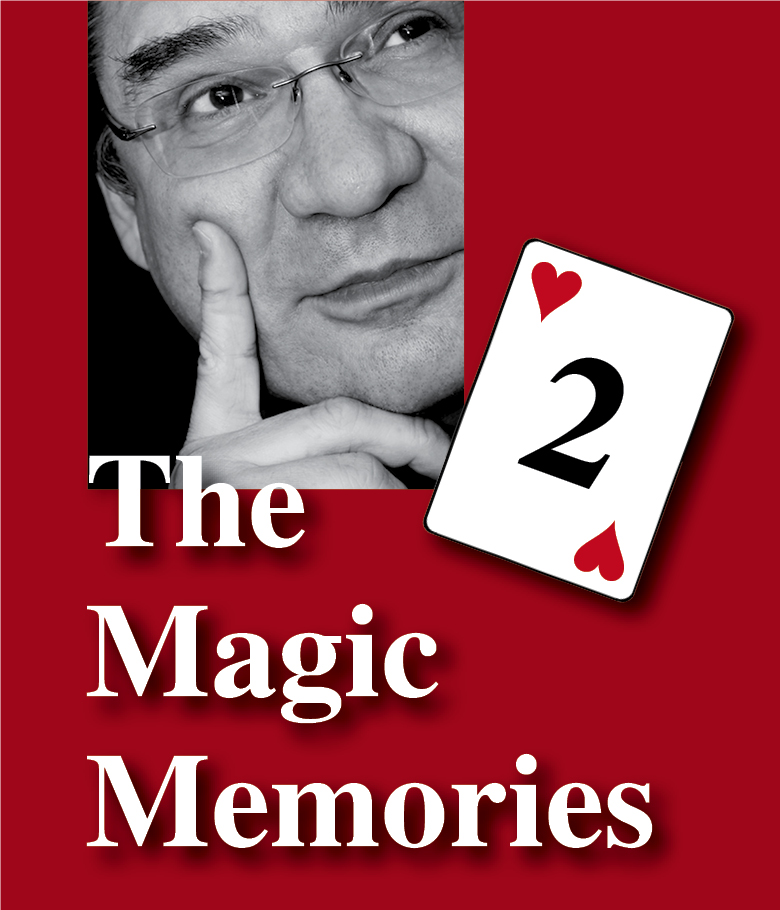
Hello everyone!
Today’s topics are: Curiosity – magic for ladies; 96 grammes new French edition of the Light Trilogy; List of tricks & bits from Sharing Secrets – Part 3 (21 – 30); Note on notes with PDF of content of Card College 3&4 – Personal Instruction AND video of Introduction.
These are The Magic Memories 80, gone online Sunday, July 10th, 2022, at 0:07h sharp.
Curiosity
In The Magic Memories 73 (22-5-22 – neat palindromic date, eh?) I quoted Nietzsche – rather than Vernon or Marlo, for a change – as having said that we should learn from the cows to ruminate.
I took this to mean that instead of running after each novelty, we should devote a good part of our time to thinking again (rumination) and a bit deeper about what we already have.
My technique in the past years has been that each time I see the advertising of a new publication – book or DVD – and which I decide not to buy, I go to some writing I already own in my library and peruse that again. “To peruse”, either means “to read through with thoroughness or care”, but also “to scan or browse”. Although these two approaches are totally different, they can both yield favorable results.
And I must say that this more often than not largely compensates for the little frustration of not having bought that new book.

So, recently I looked through Norman Hunter’s Simplified Conjuring (see cover above), one of a series of books aimed at the laity in the UK (1923!).
Imagine my surprise, when in the “Contents” (see below) I discovered the two chapters titled “Magic for Men” and “Magic for Ladies”, respectively.

I thought it extraordinary that in a magic book of 1923 the author should consider that ladies do magic, and furthermore offer specific tricks they could do. That’s unusual even by today’s standards. Or how many publications do you know who are addressed to women doing magic? So, quite progressive for the time, I thought.
However, when I went to the chapter, it turned out to be a description of tricks male magicians (how else in 1923) could do specifically for women – not even the hint of a mention of a woman performer.
This, I find, is not only curious, but also reflects what Dai Vernon used to say: “Women don’t like card tricks.” Although he specifically mentioned “cards” as the instrument of dislike to the fair sex, it still is an indication that at that time they considered women possibly did not like magic in general, and required a specific type of magic repertoire!
I’ll leave it at that for you to think about (it would certainly make for a thought-provoking essay).
(PS: In my professional experience of over three decades working internationally, I have found women to be my best but also my worst audience – more than curious…)
96 Grammes
Just received from my French publisher Frantz Réjasse and his C.C. Editions the author copies of my latest book, titled 96 grammes. This is not a “new” book, but a new edition that combines my three Light books, in English called Card College Light, Card College Lighter, and Card College Lightest.
As with all of Frantz’s books this is magnificently produced, and very fairly priced at 75 Euros, considering that the original books cost 45 Euros each.
I’ll keep this short, as being in French will interest only a small group of the readership of this blog, but here is a little riddle all of you can take some pleasure in: What does the book title 96 grammes mean? I’ll give you two hints: First, 96 grammes are the equivalent of 3.38 ounces, second, look at the photograph below… Elementary, Watson, elementary :-).

If you read French, or if you want to improve or even learn French from scratch, you can order the book directly from me, at a promotional price (!) – CLICK HERE.
If you would like me to sign the book to your name, I shall be pleased to do so, but as always you MUST mention this in the comment field of the order form (my books are often given away as a gift, especially the Light books, and I never know who finally receives the book).
BTW: I do not mean to joke when I write that you can learn a language from scratch with a magic book. Obviously, you will need to learn the grammar and some 500 words in that language first, but you can do this in 6 months or less, in any of the Latin, Germanic or Anglo-Saxon languages, English being the easiest to learn (in its basic form), and basic French is also quite easy (you only have to read it, not speak or write it, which is another universe…).
As I’ve mentioned elsewhere, the easiest and quickest way of learning a foreign language is either to get a girl/boy-friend who only speaks that language, or read a book about your passion, in our case magic. So, you can now learn any of 8 (eight!) languages by reading Card College or the Light-Trilogy, with little effort and lots of pleasure 🙂 Pit Hartling, who started out with my Card College books in German, told me he learned Spanish by buying Card College in Spanish, and then worked through it!
List of tricks & bits from Sharing Secrets – Part 3 (21 – 30)
This is the third part of a column within The Magic Memories that lists the tricks and other practical items in Sharing Secrets, as opposed to the “theories” making the body of the book. This is for all those who looked at the book as a mere “theory book”, and missed that it is full of very practical, professional and commercial performance material – I will even immodestly maintain that Sharing Secrets has more practical, lay-oriented, and performable material than many a book dealing only with tricks! Let’s see:
21 – p. 85: “The Marvelous Book”. This is an excellent example of how a presentational idea leads to a trick. Reading in an old French book (Magus, Le magicien amateur, Paris 1897) I came across the presentation for a “blow book”, that’s the one that changes the design of the pages each time you flick through it, therefore also called “flick book”. The “blow” part in the title came about because in typical presentations the performer would blow on the book, as a kind of magic enchantment, to effect the change in a dramatic sense.
It immediately occurred to me that it would be neat if the spectators could choose any literary genre, in my example a restaurant guide, and then the book in use would become just that (in the USA that could be Zagat, in Europe and now also in other parts of the world this is the Guide Michelin). Thinking about a technical solution the method described on p. 85 came to mind; and since Barbara wraps her gifts in Furoshiki- manner, that part also fell in place. It was obvious (to me) to follow this up with any type of book test…
I truly think that this makes for a beautifully coherent and logical 10-minute Mental Magic routine that works equally well in formal close-up as in parlor or small stage situations.
22 – p. 87: “Let’s Review… the Principle of Recap”. This is a simple, quick and straightforward effect, similar (but not quite the same) to Ted Annemann’s “A Card in Hand”, described in Card College 1, p. 133, but here you have the AAA-version. This is a “go-to-trick” to keep in the repertoire.
23 – p. 89: “Prologues to Ponder”. Not only do you get six (!) ready-to-use prologues for which you now merely need to find a matching trick, no, you get original presentations. If you understand this one concept, it may very well revolutionize your magic and make each and everyone of your tricks more original. Keep a notebook and write down similar ideas you are going to find practically every day, just look around and listen.
As an example look at the last item in the list, “Making the Invisible Visible”: Now go to Lesson 35 – Forces, of Card College 3&4 – Personal Instruction, and watch the performance of “The Triangle of Mystery”. It was this prologue idea, which I had taken note of years ago, that suddenly resulted in this particular trick. Every prologue is a trigger…
And remember: No trick without a prologue!
24 – p. 91: “Dice and Aces”. This is Richard Vollmer at his best, and this trick is very close to the top of my list of so-called “self-working tricks” (truth is, of course, that you still have to put in some work…).
25 – p. 93: “The Peek Control”. Use the staging and management of the Peek Control as explained here, and pair it to “The Mastergrip” from Card College 3, p. 544 (also in Lesson 25 of Card College 3&4 – Personal Instruction). You’ll have an opening card trick for the rest of your life, and a lovely way to delay a stacked deck…
26 – p. 95: “I have a normal deck here…”. You’ll get here four excellent presentational ploys, actually prologues, to get into any type of card routine. Take note.
27 – p. 97: “Seeing is Believing”. A super-lovely Four-Ace-Opener that intelligently and charmingly intrigues any sophisticated audience, much more than any finger-flinging Ace Production: The former appeals to the mind, the latter merely to the eye. Guess what will be more memorable.
28 – p. 103: “Daley’s Great Card Discovery”. It won’t be easy to find a better two-card transposition effect.
29 – p. 105: “Slydini’s One Coin Routine”. I don’t suggest you learn this, as it is one of the most difficult pieces to do really well, maybe like Beethoven’s “Moonlight Sonata”, which is considered one of the difficult pieces among piano players, but simply watch it on YouTube for inspiration of how poetic visual magic can be; most is not, in my opinion, but this one goes beyond the eye and reaches the mind and the heart.
30 – p. 107: “Practice Deck and Card Katas”. I kept these two items closely guarded for years, and only showed them to the participants of my Masterclasses – here you get them both, and for a ridiculous price.
Here we are again at the end of another ten items that in my opinion are worth taking a second look at. There is still more stuff left, and I won’t rest until this list is completed 🙂
Note on Notes
My friend Michael Frohnmeyer just wrote in – I spelled his name correctly this time 🙂 – asking about “can you help me find that trick where a blank card is shown to two spectators and turns to their selections and which is somewhere in your Card College 3&4 – Personal Instruction”.
He meant “The Triangle of Mystery” mentioned above. Clearly, this is a typical problem most will have, not just with this specific work: With 22 hours it comes as no surprise that content is at times hard to find.
If I was Harry Lorayne, I might now write: Take it from the world’s foremost expert on note-taking (me!): As you are watching the video-lessons, make copious notes for each lesson, as explained in the introduction to the course – if you do this electronically (e.g. with Evernote or OneNote, etc.) the search function will take you immediately to anything you look for.
Plus: Use the PDF with the complete content of the course. With any PDF app (I use Readdle’s PDF Expert) make notes into the PDF.
Use highlighting, underlining, and above all comments – you can add unlimited amounts of personal notes, of unlimited length, at any place within the document. The notes can be written directly into the text of the PDF, or added in small “text bubbles”.
Here is again, for your convenience, the PDF with the complete content – store it on your desktop and use it as you are watching the videos. CLICK HERE for the PDF.
And for everyone’s convenience I just decided to upload the Introduction video to Card College 3&4 – Personal Instruction, to watch CLICK HERE.

That’s all folks, as the Looney Tunes says, at least for this week, and I look forward to another session next week, always on Sundays, always at exactly 0:07 hours!
All the very best,
Roberto Giobbi

